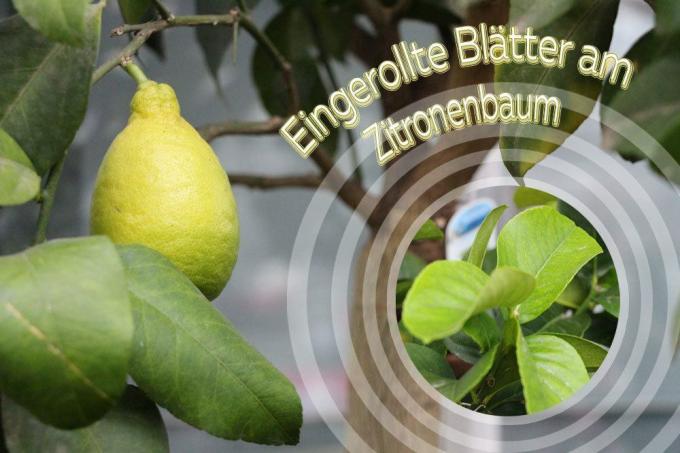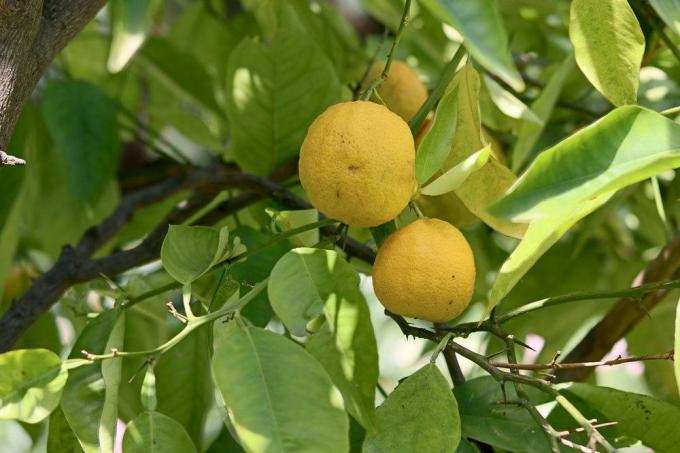
table of contents
- Lemon tree leaves curl up
- dryness
- humidity
- Frost damage
- Pests
- Scale insects
- Spider mite infestation
The decorative lemon Tree brings Mediterranean flair to the balcony or terrace. In addition to the fruits, the large, lush green leaves are also very valuable. The leaves of the lemon tree curling up can have various causes. Most of the time it is a matter of care errors, but spider mites or scale insects can also cause problems for the plant. Possible solutions for proper care and for combating pests are explained below.
Lemon tree leaves curl up
If the leaves of the lemon tree roll up, this is often due to incorrect care. The Mediterranean plants give the impression that they are frugal and do not need a lot of water. It is important here to find the right balance and not pour too much, but also not too little. There is no rule of thumb for correct watering. However, there are various signs that you can tell that the plant needs water. If you meant too well by watering, you can take various measures so that the tree can recover quickly. The right time, when you bring the tree in in autumn and when you bring it out again in spring, also plays an important role in caring for it.
dryness
Citrus plants react with rolled leaves to prolonged drought in hot summer months. They try to retain the moisture that is still there for longer, as they evaporate less with rolled-up leaves. If the dry season continues, the leaves are shed. There is a need for action to avoid this. It is best to do the following:
- If possible, take the plant out of the container
- Immerse the entire root ball in water until no more air bubbles rise
- Put the plant back in the bucket.
To allow the plant to recover, you should repeat this process for several days in a row. If you cannot take your citrus tree out of the bucket, you should put it with the bucket in the water and make sure that the top layer of the soil is also covered with water. After a few days, let the soil dry halfway and then water again. Calcareous water is also suitable for watering. Citrus limon needs more water the warmer and drier it gets.
tip: With the finger test you can determine whether the lemon tree needs water. Use your finger to drill as deeply as possible into the earth. If the soil in the middle of the pot is dry, you need to water. You can make the sample easier with a moisture meter equipped with a long probe.
humidity
If your lemon tree is too damp, the leaves will also roll up. Too much moisture can have several causes. Either you watered too much or the plant received too much rain.
The roots die off and rot. If the substrate smells musty and boggy, it can often be too late for your lemon tree. What to do if it's too damp You can avoid damage to the plant with various measures:
- carefully take the sapling out of the bucket and remove any wet soil
- let the root ball dry completely
- remove any damaged roots
- plant Citrus limon in new, dry and well-drained soil in the tub
You can use the moisture meter to check whether your plant needs water again.
Note: In the winter you should keep your lemon tree at a temperature of 5 to 10 degrees Celsius in a cool and bright room. It loses its leaves in a dark and warm room. Due to the low temperature and the lack of solar radiation, almost no water evaporates. It is enough if you water only once or twice throughout the winter.
Waterlogging
Citrus plants cannot tolerate waterlogging. The result is curled leaves. Even before planting in the tub, you can ensure that waterlogging does not occur. With a drainage in the bucket, excess water can drain off easily. For drainage, you can place potsherds over the drainage holes in the bucket and cover them with plant fleece. So no earth can be washed out of the bucket together with the excess water.
Frost damage
When there is frost, citrus trees often roll up the leaves. Dark spots on the leaves also indicate that the lemon tree is through frost suffered. It is dead tissue. If the plant has already been damaged, you can tell by the bronze discoloration of the leaves. If the branches are badly damaged, they can also turn dark. You have to cut the damaged branches back into the healthy wood. Seal the interfaces with a wound closure agent. You cannot always save your lemon tree after frost damage. You should take the right measures beforehand:
- Wrap in fleece in autumn before the first night frosts
- Place as close to the house or under a roof as possible
- Bring in the lemon tree in good time when stronger night frosts appear
- Get used to it slowly in the spring and do not put it in the blazing sun straight away
- only after the ice saints in May put them back in their usual location outdoors
Pests
The lemon tree can also be infected with spider mites or Scale insects roll up the leaves. You can often recognize an infestation with pests when many ants run over the trunk of the tree. The ants feed on the honeydew produced by various lice. Since the pests mostly attack the plant in winter, the correct winter location is important.
tip: With the right fertilization you can make your lemon tree more resistant to pest infestation. You should only fertilize in the growing season from April to August. The fertilizer should be rich in trace elements. You should only fertilize when you also water, as the plant can then absorb the fertilizer better.
Scale insects
Scale insects attach themselves to the leaves of Citrus limon and then suck them out. As a result, the leaves of the lemon tree curl up. Later they fall off. The brown scale insects can be seen with the naked eye. They leave a sticky layer on the leaves. In the case of a scale insect infestation, these solutions are helpful:
- wash the scale insects off with soapy water and a soft cloth
- spray the plant with soapy water for several days
- rinse the entire plant
- spray the plant with a 30:70 mixture of rapeseed oil and water.
When spraying the rapeseed oil solution, make sure that the leaves are completely covered with the film. The scale insects can suffocate under the film of oil. In order to also combat newly hatched scale insects, you should repeat the process several times in a row.
Spider mite infestation
Spider mites usually appear when the winter quarters for your lemon tree are too warm and the humidity is too low. These pests prefer to settle on the underside of the leaves and suck out the leaves, which then curl up. The plant should therefore be in a cool place. You should regularly check Citrus limon for pest infestation to prevent major damage. You can recognize an infestation with spider mites by the fine, gray or white webs over the leaves. You can prevent this by doing
- Place bowls filled with water in the wintering room
- use a humidifier
- Spray the plant with water that is low in lime.

If your lemon tree is already infested, you can spray your tree several times a week with a squirt bottle. In doing so, you should be careful not to
Moisture gets to the roots and no waterlogging forms. If the infestation is more severe, you can also use a natural pest control agent that is also suitable for fruit growing. Naturen organic pest-free for fruit and vegetables combats not only spider mites but also aphids, scale insects, mealybugs and mealybugs.


